
Format: Hardback
Pages: 224
ISBN: 9781636245003
Pub Date: 31 Jan 2025
Illustrations: 10 images
Description:
A compelling novel about a young man's entry into the Vietnam War, and how that boy becomes a man under extraordinary circumstances, written by a former Green Beret. Join Garner, Dodge, and the rest of RT Iowa as they venture "across the fence" to stem the flow of the North Vietnamese on the Ho Chi Minh Trail.

Format: Paperback
Pages: 128
ISBN: 9781636244792
Pub Date: 31 Jan 2025
Illustrations: Over 120 photographs and illustrations
Description:
The summer of 1863 started off disastrously for the Army of the Potomac in the Eastern Theater. In early May, Confederate General Robert E. Lee’s Army of Northern Virginia defeated and humiliated Major General Joseph Hooker’s army at the Battle of Chancellorsville.
While both armies reorganized in the wake of Chancellorsville’s massive losses, Lee then maintained the initiative and launched an invasion of Pennsylvania. Throughout June, Lee’s army advanced deeper into Pennsylvania and Northern efforts to stop his progress were ineffective until Major General George Meade replaced Hooker as commander of the Army of the Potomac. On July 1, 1863, Meade and Lee’s large armies collided outside of the crossroads town of Gettysburg, Pennsylvania. The stakes were never higher for either army as the newly promoted Meade defended Northern soil, while General Lee risked everything by taking the war into enemy territory.The first day of the Battle of Gettysburg is often overshadowed by fighting on the following days, but July 1 was one of the bloodiest single engagements of the entire Civil War. Many of the decisions leading to and through Gettysburg’s first day remain steeped in controversy. Did Meade intend to fight on the Pipe Creek line in Maryland until subordinates such as Major General John Reynolds forced the engagement at Gettysburg? Did the absence of J. E. B. Stuart’s cavalry really leave Lee “blind” to his opponent’s movements? Was Lee’s desire to avoid a general engagement ignored by his own officers? With neither commanding general on the battlefield for much of the day, crucial decisions remained in the hands of subordinates such as John Buford, John Reynolds, A. P. Hill, Richard Ewell, and Oliver Howard.This Casemate Illustrated volume sets the stage for the Civil War’s greatest battle and covers the heroism, decisions, and mistakes made on the first day at Gettysburg.
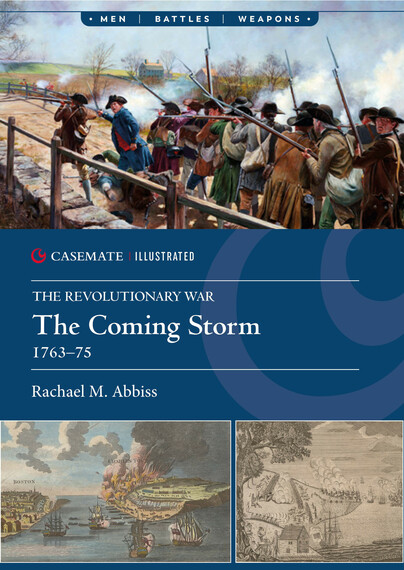
Format: Paperback
Pages: 128
ISBN: 9781636240923
Pub Date: 31 Dec 2024
Illustrations: 100 photographs and illustration
Description:
The 17th and 18th centuries witnessed a period of almost constant conflict in Europe and North America. In New England, the threat of invasion from the French in the North and the Spanish in the South weighed heavily on the colonists. The Crown's solution was to send an army from Britain to help govern, organise and protect the colonies, but ultimately this was not enough to secure loyalty and quell the whispers of revolt.
For over a century, discontent simmered, but allegiance to the Crown and the military protection provided by Britain superseded – at least initially – the majority of grievances. Before 1763, many colonists fought for King and Country during multiple battles and the monarchy had demonstrated an ability to support and defend the colonies. Over time, however, Britain and the colonists disagreed on methods of governance and taxation, and how best to protect territory and trade. As wars waged on, allegiances became strained and imperial control required a different and perhaps more considered approach. This was not forthcoming, as Crown and Parliament continued to tighten political and economic rule, which both divided and provoked the colonists. Some, such as the political propagandist Thomas Paine, eventually argued: 'the period of debate is closed… 'TIS TIME TO PART.'
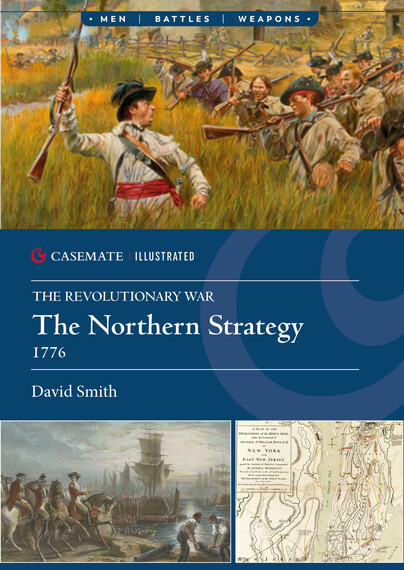
Format: Paperback
Pages: 128
ISBN: 9781636240787
Pub Date: 31 Dec 2024
Illustrations: 100 photographs and illustration
Description:
Having declared their independence, Britain's former colonies in North America would need to fight for their liberty. The response from the other side of the Atlantic was slow, but when it arrived it appeared overwhelming. Hundreds of ships and tens of thousands of troops gathered to re-establish the Crown's control.
If the Revolution was not to die in its first year, the Americans would need to take on the largest expeditionary force ever sent by Great Britain up to that point… with an army of amateurs.The 1776 campaign saw a nearly uninterrupted string of British victories; at Long Island, White Plains and Fort Washington the Americans proved unable to stand against the disciplined regulars led by General William Howe, who received a knighthood for his efforts. The war appeared all but over as General George Washington led the tattered remnants of his army to safety at the end of the year, but as British thoughts turned to the next campaign, Washington showed that he was not yet finished, winning significant morale-boosting victories at Trenton and Princeton.Detailing the armies, commanders, strategies and tactics employed on both sides, The Northern Strategy, 1776 takes a fresh look at one of the most remarkable campaigns of the 18th century, one in which the British failed to secure their longed-for knockout blow and instead found themselves drawn into a long and painful war of attrition.
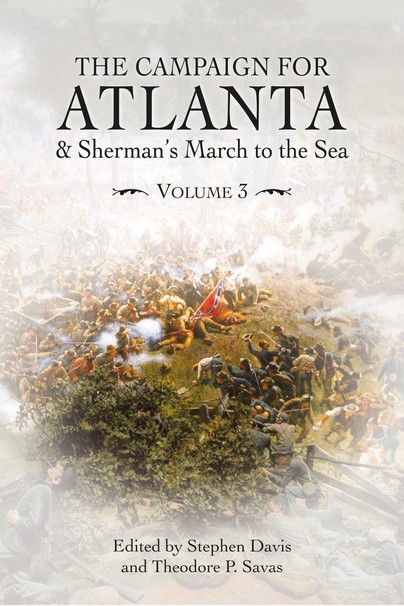
Format: Paperback
Pages: 288
ISBN: 9781611216974
Pub Date: 15 Dec 2024
Illustrations: 12 images, 6 maps
Description:
By the time Albert Castel’s Decision in the West: The Atlanta Campaign of 1864 appeared in 1992, Savas Woodbury Publishers had already made important contributions to the campaign scholarship by publishing a collection of original essays by some of the field’s most noted authors, including Steven Woodworth, writing about the Confederacy’s command options in the Winter of 1863-64. Editors Theodore P. Savas and David A.
Woodbury next assembled another group of articles that included such luminaries as Richard McMurry and William R. Scaife. The pair of paperbacks were published together in 1994 in a special hardcover edition with fold-out maps entitled The Campaign for Atlanta & Sherman’s March to the Sea, Volumes I and II. Now, almost three decades later, Savas Beatie proudly announces the publication of its third volume in the series. Once again, cutting-edge scholarship is presented in such essays as Brian Wills’ “Forrest and Atlanta” and Larry Daniel’s “The Adairsville Affair.” Stephen Davis wonders why the battle of Jonesboro (August 31-September 1) still draws so much attention when Federal troops had already cut Hood’s last railroad line into Atlanta, sealing the fate of the city even before the battle had begun.Additional essays address the impact of Sherman’s campaigns on Georgia women, Joe Johnston’s self-aggrandizing campaign accounts, and more.Like its predecessors, The Campaign for Atlanta and Sherman’s March to the Sea, Volume 3 will be highly sought by students of the campaign, and western theatrists in general.
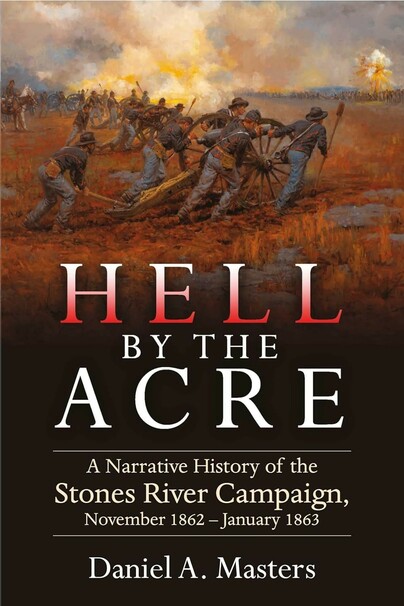
Format: Hardback
Pages: 640
ISBN: 9781611217124
Pub Date: 15 Nov 2024
Illustrations: 25 images, 17 maps
Description:
The waning days of 1862 marked a nadir in the fortunes of the Union. After major defeats at Fredericksburg in Virginia and Chickasaw Bayou in Mississippi, it fell to Maj. Gen.
William S. Rosecrans and his Army of the Cumberland to secure a victory that would give military teeth to the Emancipation Proclamation set to take effect on January 1, 1863. Rosecrans moved his army out of Nashville on the day after Christmas to Murfreesboro, met
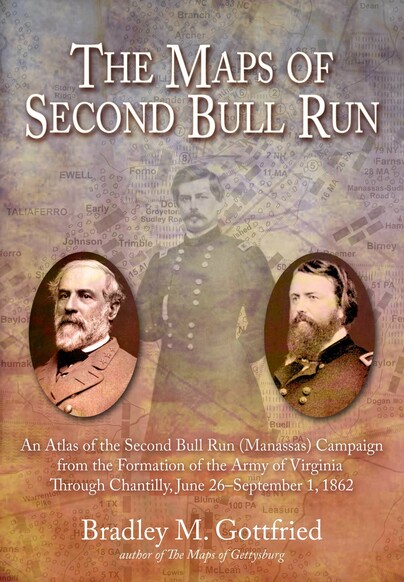
Format: Hardback
Pages: 352
ISBN: 9781611217087
Pub Date: 15 Nov 2024
Series: Savas Beatie Military Atlas Series
Illustrations: 2 images, 122 maps
Description:
The Maps of Second Bull Run: An Atlas of the Second Bull Run/Manassas Campaign from the Formation of the Army of Virginia Through the Battle of Chantilly, June 26 – September 1, 1862, continues Bradley M. Gottfried’s efforts to study and illustrate the major campaigns of the Civil War’s Eastern Theater. This is his tenth book in the ongoing Savas Beatie Military Atlas Series.
President Abraham Lincoln’s frustration with George B. McClellan’s inability to defeat Robert E. Lee’s Army of Northern Virginia and capture Richmond dramatically increased after the unsuccessful Seven Days’ Battles. The president combined three small armies into the new Army of Virginia and placed it under Maj. Gen. John Pope, who had overseen several successes in the Western Theater.Pope’s growing aggressiveness, combined with McClellan’s passive posture on the Peninsula, forced Lee to turn his attention toward the new threat from the north. Thomas “Stonewall” Jackson moved his wing of the Army of Northern Virginia to confront Pope. A bloody battle at Cedar Mountain on August 9 halted Pope’s move south, and Jackson’s raid on the vast stores at Manassas Junction triggered another confrontation, this time at Kettle Run.As Jackson settled into a defensive position on the plains of Manassas, and with McClellan’s troops having abandoned the Peninsula, Lee moved his other wing under James Longstreet rapidly north. Pope missed an opportunity to prevent the junction of Lee’s wings by not stopping Longstreet at Thoroughfare Gap.The Battle of Second Bull Run began on the evening of August 28 when Jackson tangled with Union troops at the Brawner Farm. Pope spent much of the following day hammering Jackson’s front, with no idea that Longstreet had arrived on the field. The Union assaults continued on August 30 until Longstreet launched a massive assault that rolled up the Union left flank and collapsed Pope’s army. The retreat was briefly interrupted by some of Jackson’s units at Chantilly, which ended the campaign.The Maps of Second Bull Run plow new ground by breaking down the entire campaign into sixteen map sets or “action sections,” enriched with 122 detailed full-page color maps. These cartographic originals bore down to the regimental and battery level. They include the march to and from the battlefields and virtually every significant event in between. At least two—and as many as ten—maps accompany each map set. Keyed to each piece of cartography is a full-facing page of detailed text describing the units, personalities, movements, and combat (including quotes from eyewitnesses) depicted on the accompanying map, all of which make the cavalry actions come alive.This presentation allows readers to easily find a map and text on virtually any portion of the campaign. Serious students will appreciate the extensive endnotes and complete order of battle and take the book with them to the battlefields. A final bonus is that the maps unlock every other book or article written on any aspect of the campaign.Perfect for the easy chair or for stomping the hallowed grounds, The Maps of Second Bull Run is a seminal work that belongs on the bookshelf of every serious and casual student of the battle.
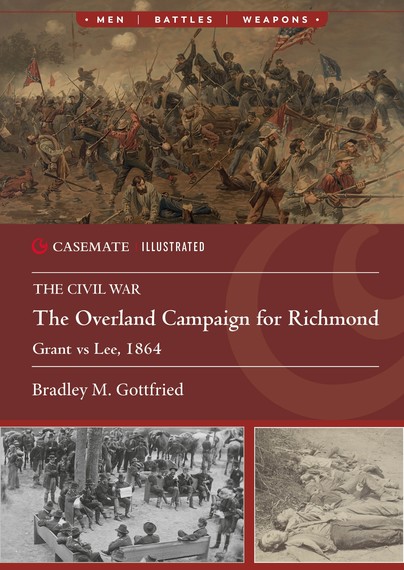
Format: Paperback
Pages: 128
ISBN: 9781636243924
Pub Date: 15 Nov 2024
Description:
A full account of the Wilderness to the James River, including Grant's rise to high command, the condition of the armies going into the critical 1864 campaign, a deep look at the commanders on both sides, and the strategy of the campaign from both perspectives. The study is combat, strategy, and tactics from the first day of action until the last, when Grant—unable to capture Richmond, but now south and east of the capital—builds a long bridge and crosses the James River to attack Petersburg. Illustrated by photographs and excellent maps, it will conclude with a note about visiting the battlefields, the casualties, the treatment of wounded, and the burial of the dead.
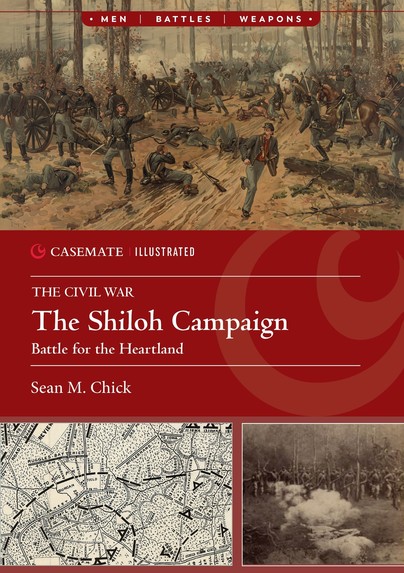
Format: Paperback
Pages: 128
ISBN: 9781636243696
Pub Date: 15 Nov 2024
Illustrations: 100-120 photographs, artworks and maps
Description:
After taking Forts Henry and Donelson, the Union army prepared to try and take the vital rail hub of Corinth, Mississippi. To facilitate this, Major General H. Halleck planned to combine Grant’s Army of West Tennessee with Buell’s Army of the Ohio.
Meanwhile the newly formed Confederate Army of the Mississippi was placed under the command of General A. S. Johnston. Johnston planned to attack Grant’s encampment before Grant and Buell could combine their commands.The Confederate army left Corinth and marched north into Tennessee. On the morning of April 6, 1862, Johnston attacked at Shiloh, taking Grant’s forces by surprise. Grant’s troops put up a tenacious defense with their backs against the Tennessee River. Unfortunately for the Confederates, Johnston was killed early that afternoon. Buell’s army arrived that night and next morning launched a counterattack along with Grant’s semi-organized survivors. The Union forces were too large to be stopped, and after a stout defensive effort Beauregard ordered a withdrawal. The first great bloodbath of the Civil War was over, resulting in up to 30,000 killed, wounded, and captured. Its ramifications would be felt for the rest of the war.Illustrated with photographs, paintings and maps, this is a full account of the first large set-piece battle of the war, the only time a large Union army was taken by surprise.
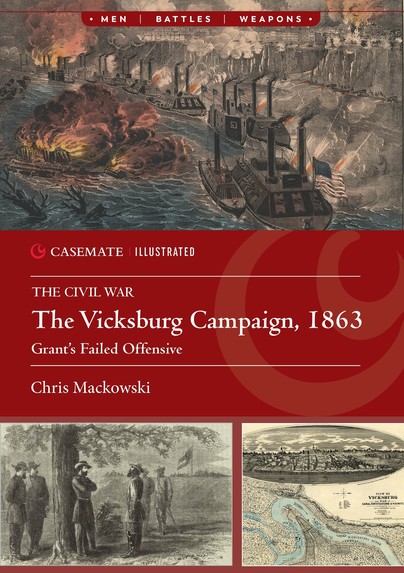
Format: Paperback
Pages: 128
ISBN: 9781636243733
Pub Date: 15 Nov 2024
Illustrations: 100-120 photographs, artworks and maps
Description:
The 14-month campaign to regain the control of Mississippi River by capturing Vicksburg, Mississippi stands as the prime example of how the Civil War would be fought and won. The Federal government’s policy of blockading the southern ports and controlling the inland waterways would only be successful with total control of the country’s largest river. Technological advances created by the war itself and used by progressive thinking Federal and Confederate commanders ensured that this vital southern supply and logistics base would be the focal point of the war on the western waters.
Ulysses S. Grant, who had risen to fame as one of the North’s prominent heroes early in the war, boldly concluded that Vicksburg would be the next nut to crack in the Federal policy for control of the Mississippi River. Understanding that only a strong relationship with US Navy could ensure the success of Vicksburg’s surrender, Grant found a man as bold and daring as himself in David Dixon Porter and his Mississippi Squadron of ironclad gunboats and fleet of vessels. These two commanders and their trusted subordinates would frustrate John C. Pemberton’s attempts to defend Mississippi and eastern Louisiana for the Confederacy. A lack of experience in commanding such an important assignment, limited resources, poor staffing, and a Confederate government consumed with the war in the east ensured Pemberton’s position would be insurmountable as the Confederacy’s tenuous hold on the Mississippi River began to fall apart.

Format: Paperback
Pages: 128
ISBN: 9781636243900
Pub Date: 15 Nov 2024
Illustrations: 100– illustrations
Description:
By the end of March 1863, Major General Ulysses S. Grant was at a crossroads in his military career. His bold attempts in the late fall 1862 and winter of 1862/63 had all come up fall short of his objective: get his army on high ground north and east of Vicksburg and capture the last major obstacle on the Mississippi River.
Grant had been stymied by the difficult region’s swampy bayous as well as Confederate resistance at key locations that thwarted his advances and prolonged his army’s miserable dispositions in the sickly camps of Louisiana bottomland. Confederate Lieutenant General John C. Pemberton had performed well using his interior rail lines and intelligence networks to place blocking forces or obstructions that delayed or derailed Grant’s movements.Realizing his career was on the line, Grant chose the riskiest operation he could have concocted. In a joint military operation, Grant marched two of his army corps down the roads and along the bayous of Louisiana, repairing them as they progressed, while Acting Rear Admiral David Dixon Porter led his ironclad gunboats with transports past the Confederate heavy artillery defending Vicksburg’s riverfront. It was Grant’s hope to get enough boats below the city to enable a crossing of the Mississippi River, a forced march into the state, and arriving at Vicksburg’s doorsteps from the east–west approach. In doing this, Grant would severe his main line of logistics and supply, something his subordinate officers thought was a disastrous mistake. Grant would take the risk in a zero-sum game: he would capture Vicksburg or destroy himself and his army doing so.This Casemate Illustrated examines the movements of the Union and Confederate armies from March 1863 through July 1863, the joint-operational cooperation between the U.S. Army and U.S. Navy, the delayed and indecisive Confederate operations to stop the Federal initiative, and how the individual soldiers conducted the one of the greatest campaigns in American military history: to control the “The Father of Waters”—the Mississippi River.
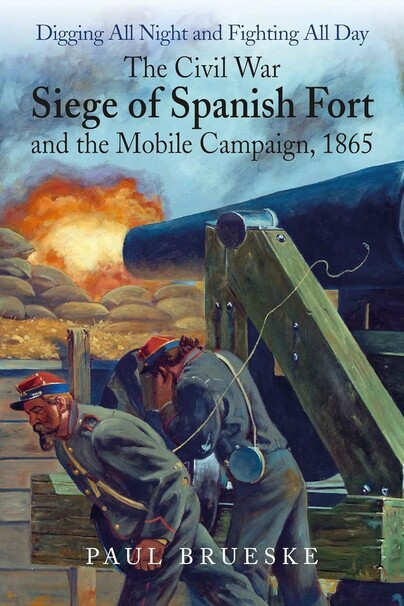
Format: Hardback
Pages: 256
ISBN: 9781611217100
Pub Date: 15 Oct 2024
Illustrations: 52 images, 9 maps
Description:
The bloody two-week siege of Spanish Fort, Alabama (March 26-April 8, 1865) was one of the final battles of the Civil War. Despite its importance and fascinating history, surprisingly little has been written about it. The fall of the fort was considered by many the key to the surrender of the important seaport of Mobile, which fell to Maj.
Gen. Edward R. S. Canby on April 12, 1865. Paul Brueske’s Digging all Night and Fighting All Day: The Civil War Siege of Spanish Fort and the Mobile Campaign, 1865 is the first full-length study of this subject.General U. S. Grant had long had his eyes set on capturing Mobile. Its fall would eliminate the vital logistical center and put one of the final nails in the coffin of the Confederacy. On January 18, 1865, Grant ordered General Canby to move against Mobile, Montgomery, and Selma, and destroy anything useful to the enemy’s war effort. The reduction of Spanish Fort, along with Fort Blakeley—the primary obstacles to taking Mobile—was a prerequisite to capturing the city.After the devastating battles of Franklin and Nashville in Tennessee in late 1864, many Federals believed Mobile’s garrison—which included a few battered brigades and most of the artillery units from the Army of Tennessee—did not have much fight left and would evacuate the city rather than fight. They did not. Despite being outnumbered about 10 to 1, 33-year-old Brig. Gen. Randall Lee Gibson mounted a skillful and spirited defense that “considerably astonished” his Union opponents. The siege and battle that unfolded on the rough and uneven bluffs of Mobile Bay’s eastern shore, fought mainly by veterans of the principal battles of the Western Theater, witnessed every offensive and defensive art known to war.Paul Brueske, a graduate student of History at the University of South Alabama, marshaled scores of primary source materials, including letters, diaries, reports, and newspaper accounts, to produce an outstanding study of a little-known but astonishingly important event rife with acts of heroism that rivaled any battle of the war.
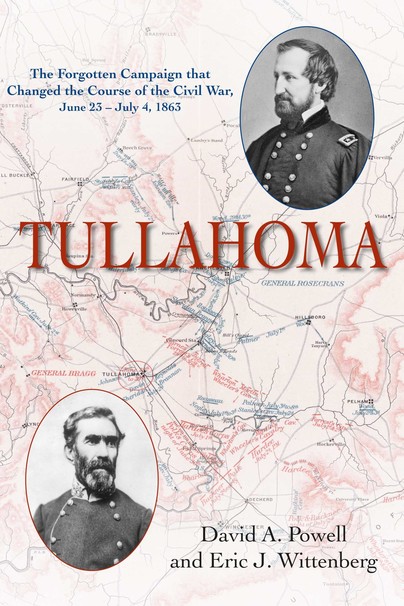
Format: Hardback
Pages: 408
ISBN: 9781611215045
Pub Date: 15 Aug 2024
Illustrations: 16 maps, 50 images
Description:
July 1863 was a momentous month in the Civil War. News of Gettysburg and Vicksburg electrified the North and devastated the South. Sandwiched geographically between those victories and lost in the heady tumult of events was news that William S.
Rosecrans’s Army of the Cumberland had driven Braxton Bragg’s Army of Tennessee entirely out of Middle Tennessee. The brilliant campaign nearly cleared the state of Rebels and changed the calculus of the Civil War in the Western Theater. Despite its decisive significance, few readers even today know of these events. The publication of Tullahoma: The Forgotten Campaign that Changed the Course of Civil War, June 23 - July 4, 1863 by award-winning authors David A. Powell and Eric J. Wittenberg, forever rectifies that oversight. On June 23, 1863, Rosecrans, with some 60,000 men, initiated a classic campaign of maneuver against Bragg’s 40,000. Confronted with rugged terrain and a heavily entrenched foe, Rosecrans intended to defeat Bragg through strategy rather than bloodshed by outflanking him and seizing control of Bragg’s supply line, the Nashville& Chattanooga Railroad, at Tullahoma and thus force him to fight a battle outside of his extensive earthworks. It almost worked. The complex and fascinating campaign included deceit, hard marching, fighting, and incredible luck - both good and bad. Rosecrans executed a pair of feints against Guy’s Gap and Liberty Gap to deceive the Rebels into thinking the main blow would fall somewhere other than where it was designed to strike. An ineffective Confederate response exposed one of Bragg’s flanks - and his entire army - to complete disaster. Torrential rains and consequential decisions in the field wreaked havoc on the best-laid plans. Still Bragg hesitated, teetering on the brink of losing the second most important field army in the Confederacy. The hour was late and time was short, and his limited withdrawal left the armies poised for a climactic engagement that may have decided the fate of Middle Tennessee, and perhaps the war. Finally fully alert to the mortal threat facing him, Bragg pulled back from the iron jaws of defeat about to engulf him and retreated - this time all the way to Chattanooga, the gateway to the rest of the Southern Confederacy. Powell and Wittenberg mined hundreds of archival and firsthand accounts to craft a splendid study of this overlooked campaign that set the stage for the Battles of Chickamauga and Chattanooga, the removal of Rosecrans and Bragg from the chessboard of war, the elevation of U.S. Grant to command all Union armies, and the early stages of William T. Sherman’s Atlanta Campaign. Tullahoma - one of the most brilliantly executed major campaigns of the war—was pivotal to Union success in 1863 and beyond. And now readers everywhere will know precisely why.
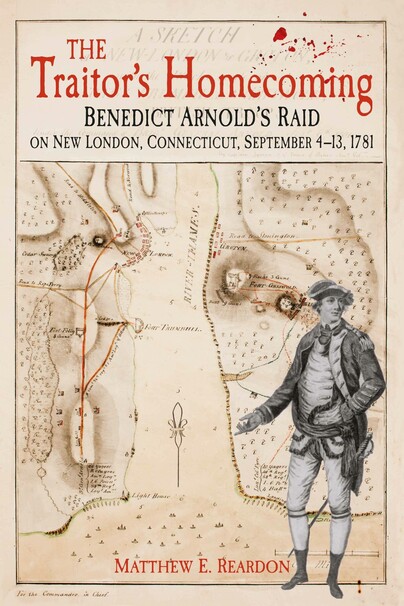
Format: Hardback
Pages: 372
ISBN: 9781611216981
Pub Date: 01 Jul 2024
Illustrations: 40 images, 12 maps
Description:
Almost everyone is familiar with the name of at least one Revolutionary War battle. Some, like Lexington and Concord, Bunker Hill, and Yorktown are nearly household names. Others are less well known but readily recognized when mentioned.
An engagement in a New England colony during the war’s sixth year, commanded by one of history’s most famous military names, is not among them. Matthew E. Reardon has set out to rectify that oversight with the publication of The Traitor’s Homecoming: Benedict Arnold’s Raid on New London, Connecticut, September 4-13, 1781.By 1781, Britian was at risk of losing the colonies. The combined Franco-American armies of Gens. George Washington and Jean-Baptiste comte de Rochambeau spent much of that August deceiving British General Sir Henry Clinton into believing they were moving on him to lay siege against to New York City. In fact, they were moving south toward Yorktown, Virginia, in a bid to trap Lord Cornwallis’ army against the sea. Clinton, meanwhile, dispatched former American general Benedict Arnold across Long Island Sound to attack New London, hoping the move would derail reinforcements and supplies headed toward the city.Situated in southeastern Connecticut, New London was the center of the state’s naval activities. State and continental vessels were constructed within its harbor, which doubled as a haven for American privateers. Arnold landed on September 6 and, in a textbook operation, defeated local militia, took possession of the town, harbor, and forts, and set New London’s waterfront ablaze. But that is not how it is remembered. The state government’s vicious propaganda campaign against the British and Arnold, who was already infamous for his treachery, created a narrative of partial truths, myths and legends that persist to this day. The true story, however, is much more than the bloody fighting and “massacre” at Fort Griswold.The Traitor’s Homecoming utilizes dozens of newly discovered British and American primary sources to weave together a balanced military study of an often forgotten and misunderstood campaign. Indeed, Reardon achieves a major reinterpretation of the battle while dismantling its myths. Thirteen original maps and numerous illustrations and modern photographs flesh out this groundbreaking study.
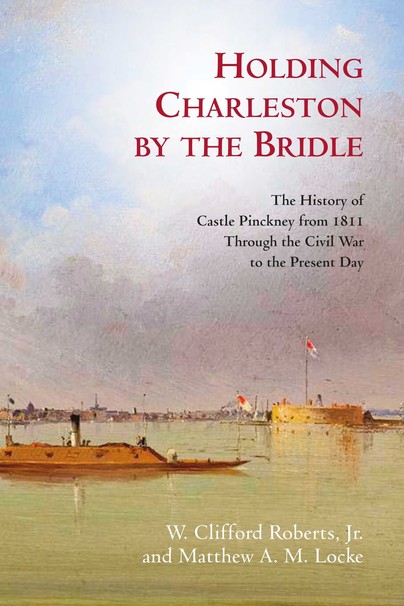
Format: Hardback
Pages: 240
ISBN: 9781611217148
Pub Date: 15 Jun 2024
Illustrations: 62 images, 1 map
Description:
On the eve of the Civil War, the London Times informed its readers that Castle Pinckney has “been kept garrisoned, not to protect Charleston from naval attack from the ocean, but to serve as a bridle upon the city.” Located on a marshy island in the center of Charleston’s magnificent harbor, the large cannons on the ramparts of this horseshoe-shaped masonry fort had the ability to command downtown Charleston and the busy wharves along East Bay Street. This inescapable fact made Castle Pinckney an important chess piece in the secession turmoil of 1832 and 1850, and in the months leading up to the 1861 bombardment of Fort Sumter.
Holding Charleston by the Bridle: The History of Castle Pinckney from 1811 Through the Civil War to the Present Day by Cliff Roberts and Matthew Locke is the first book on the subject, from the fort’s innovative design as part of America’s “Second System” of coastal fortifications to the modern challenges of preserving its weathered brick walls against rising sea levels. The impressive bastion was constructed as a state-of-the-art seacoast fortress on the eve of the War of 1812. President James Monroe and Gens. Winfield Scott, Robert E. Lee, and P. G. T. Beauregard inspected its casemates and barracks. The history of Pinckney is as impressive as its list of visiting VIPs.Defending the fort was one of Winfield Scott’s major concerns during the Nullification Crisis of 1832. Seminole Indians and Africans from the illegal slave ship Echo were held there. In 1860, Maj. Robert Anderson knew the fort was the key to protecting his small Federal garrison at Fort Moultrie, but his requests to Washington for troops to hold the Castle went unheeded. That December, three companies of Charleston militia scaled and seized the fort in a daring act that pushed the nation to the edge of civil war. After First Manassas (Bull Run), 156 captured Yankee officers and enlisted men were sent to the island, and in 1863, members of the famed 54th Massachusetts were held there as POWs. The fort’s guns helped defend the city during the war’s longest siege. By 1865, the old fortress had been transformed into an earthen barbette battery with a rifled Brooke gun and three giant 10” Columbiads. During Reconstruction, the Castle became an “American Bastille” for Southerners accused of crimes against the government.Roberts and Locke rely on extensive primary research and archaeological evidence to tell the full story of the Castle for the first time. Given its importance to America’s history, it is a history long overdue.
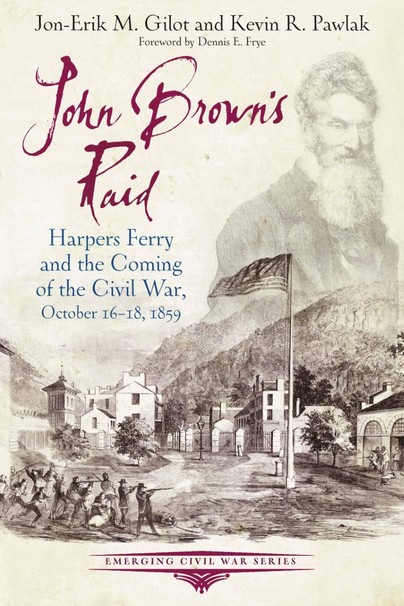
Format: Paperback
Pages: 192
ISBN: 9781611215977
Pub Date: 10 May 2024
Series: Emerging Civil War Series
Illustrations: 150 images, 10 maps
Description:
The first shot of the American Civil War was not fired on April 12, 1861, in Charleston, South Carolina, but instead came on October 16, 1859, in Harpers Ferry, Virginia - or so claimed former slave turned abolitionist Frederick Douglass. The shot came like a meteor in the dark. John Brown, the infamous fighter on the Kansas plains and detester of slavery, led a band of nineteen men on a desperate nighttime raid that targeted the Federal arsenal at Harpers Ferry.
There, they planned to begin a war to end slavery in the United States. But after 36 tumultuous hours, John Brown's Raid failed, and Brown himself became a prisoner of the state of Virginia. Brown's subsequent trial further divided north and south on the issue of slavery as Brown justified his violent actions to a national audience forced to choose sides. Ultimately, Southerners cheered Brown's death at the gallows while Northerners observed it with reverence. The nation's dividing line had been drawn. Herman Melville and Walt Whitman extolled Brown as a "meteor" of the war. Roughly one year after Brown and his men attacked slavery in Virginia, the nation split apart, fueled by Brown's fiery actions. John Brown's Raid tells the story of the first shots that led to disunion. Richly filled with maps and images, it includes a driving and walking tour of sites related to Brown's Raid so visitors today can walk in the footsteps of America's meteor.
















